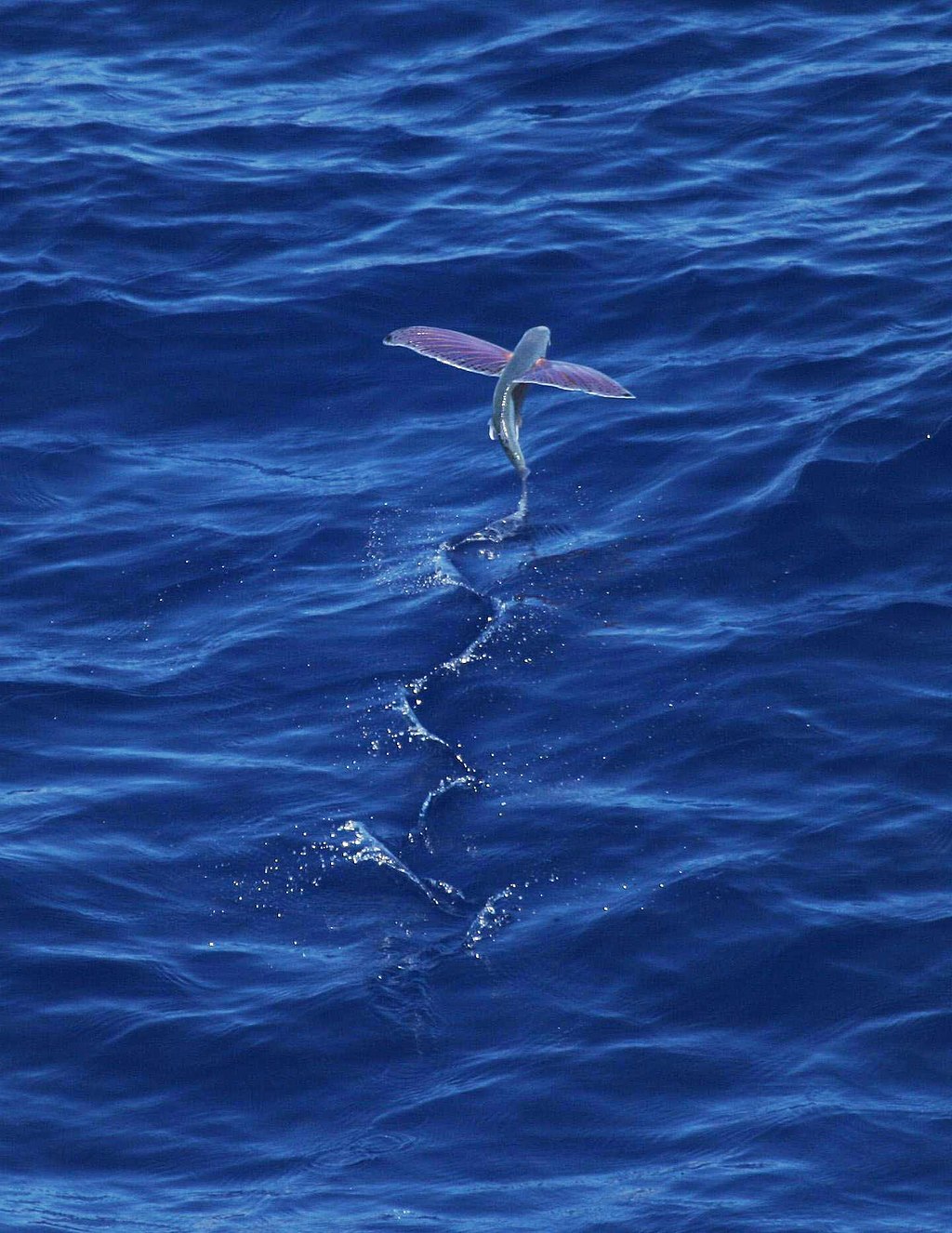 |
| "Pink-wing flying fish" by http://www.moc.noaa.gov/mt/las/photos2.htm. Licensed under Public Domain via Wikimedia Commons |
Idealists speak of Spirit and materialists project Spirit into matter giving it divine properties.
So to speak.
But his pattern in world views does seem to hold at least in modern Evolutionary Biology with rather shockingly jaw dropping baseless statements hidden in the parlance. A case study of this is a recent interesting and educational BBC Earth report on earliest flying living things presented by Colin Barras describes the work on early flight by Guang Hui Xu and his team at the Chinese Academy of Sciences in Beijing. I quote (emphasis added):
Some animals get all the glory. That's doubly true when it comes to one of nature's most spectacular feats: flying.Divine evolution
We're all familiar with the birds and the bees – and other insects. Bats are also well-known for their aerobatics. And lovers of spectacular prehistoric beasts will know about the pterosaurs - extinct flying reptiles, some of which had the 10m wingspan of a light aircraft.
But the annals of flight carry the tales of plenty more pioneering species. From prehistoric flying fish and jet-propelled squid to flying trees and truly weird gliding reptiles, these are the aeronauts you never knew existed.
...
Insects were the first group to achieve the feat: they developed wings at least 320 million years ago. Pterosaurs were the first vertebrates - animals, like us, with a backbone - to evolve powered flight, about 230 million years ago. Even more recently, bats were the first mammals to truly fly, beginning about 50 million years ago.
But this famous four are far from being the only flight pioneers. At least two groups of backboned animals beat the pterosaurs into the air by millions of years.
...
All of today's flying fish are closely related to one another, and belong to a family called the exocoetids. They aren't much older than bats, having evolved perhaps 65 million years ago, and we don't know much about how they did so, says Guang-Hui Xu at the Chinese Academy of Sciences in Beijing.
But an earlier, now extinct group of fish called the thoracopterids turned their fins into wings at least 240 million years ago. In January 2015, Xu and his colleagues explained how they did so, with the help of some new primitive thoracopterid fossils from China.
...
"Over-water gliding adaptations were gradual in nature," says Xu. The process began in the skull. The new fossils, called Wushaichthys, had a broad and flat skull roof typical of thoracopterid fossils. This possibly helped the fish swim and feed just below the ocean's surface.
The second step was the crucial one. Some thoracopterid fossils from around the same time added a specialised tail fin, with a lower fork much longer than the upper fork. It's this asymmetrical fin that helped thoracopterids gain enough power when swimming to jump out of the water, making it the key characteristic for identifying flying fish, says Xu.
Only later did the thoracopterids evolve the wing-like fins that allowed them to make best use of their jumps, by gliding.
Finally, the thoracopterids lost their body scales, perhaps because doing so made it easier to wiggle during glides to improve flight efficiency.
The ancient thoracopterid fossils give us a good idea how today's flying fish evolved. Modern exocoetid flying fish also have broad skulls, asymmetric tail fins and long wing-like fins, and probably evolved in a similar way, says Xu.
It might seem odd that fish evolved the same flying ability twice, but perhaps the bigger surprise is that they didn't do it more often. After all, a host of land animals have evolved the ability to glide. Xu says it's because gliding over land is very energy-efficient, whereas gliding over the ocean isn't. "The gliding of flying fishes is energetically very expensive," he says.
Read the entire article from BBC Earth
Isn't it amazing how thoracopterids evolved for themselves first a broad and flat skull roof, then added a specialised tail fin and then wing-like fins for better gliding. It was a bit uncomfortable so they lost their body scales to wiggle more easily.
I mean, well, that fish is swimming near the surface and there is plenty of air up there above the water, so it thinks how the heck do I get in the air and glide without the resistance of water - wow, I might even make ten meters fast glides and escape predators, if the wind is good! But how to do it with this body given to me? Oh well, I better modify my head, tail fin and front fins and get rid of body scale - that should do it!
Scholar projecting divine genius into spontaneous evolution as if he was speaking of something self-evident and prove, a process presumably guided by natural test and try through selection - survival of the best glider!
Creationist and ID problem
Now the idealist notices that there is nothing that would support the materialistic atheist view of a thoracopterids attempting to turn themselves into flying animal and succeeding in it with significant body modifications.
So the Intelligent Design person introduces the Spirit saying that the evolution of thoracopterids is in fact divine intervention in the life cycle of an animal. The genius is not in the natural process which is a stupid unproven claim but rather in the invisible hidden Spirit creating living things and giving them amazing abilities.
The problem in the idealistic view is that it does not explain anything and does not add anything to the mystery of how these amazing fossil fish came into being. It is simply a statement that may well be true that God has created all things but it is not a scientific or any kind of explanation.
What to do?
If materialistic divine evolution is nonsense and if religious idealistic Spirit does not add to our knowledge what should we do?
I think we should admit just that.
Instead of carelessly throwing sentences of how a living creature evolves itself Professor Guang Hui Xu and science reporter Colin Barras could say that despite many fine theories modern science is unable to explain why a fish starts to fly.
Instead of dogmatically throwing sentences of how Spirit wisely and purposely creates a flying fish from a swimming fish ID people could say "praise the Lord for His wisdom that can be seen in this. But we need proper scientific theories if we want to understand what happened."
It is not a shame to confess our lack of knowledge and it is exactly that attitude that might encourage new young scholars to come forward with new ideas about evolution in Nature without being ridiculed by a die-hard Darwinist or believing Creationist.
